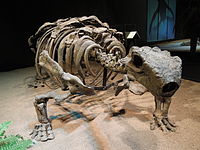Archosauromorphs
Dinosaurs
| Name | Novelty | Status | Authors | Age | Type locality | Location | Notes | Images |
|---|---|---|---|---|---|---|---|---|
| Saurolophus angustirostris [2] | Sp. nov. | Valid | Rozhdestvensky | Maastrichtian | Nemegt Formation | A species of Saurolophus | ||
| Syrmosaurus viminocaudus [3] | Gen. et sp. nov. | Jr. synonym | Maleev | Campanian | Djadochta Formation | Junior synonym of Pinacosaurus | ||
| Talarurus plicatospineus [4] | Gen. et sp. nov. | Valid | Maleev | Cenomanian-Santonian | Bayan Shireh Formation | An ankylosaurid |  | |

